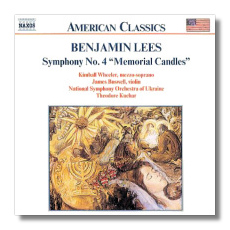
The Internet's Premier Classical Music Source
Related Links
- Lees Reviews
- Latest Reviews
- More Reviews
-
By Composer
-
Collections
DVD & Blu-ray
Books
Concert Reviews
Articles/Interviews
Software
Audio
Search Amazon
Recommended Links
Site News
 CD Review
CD Review
Benjamin Lees

Symphony #4 "Memorial Candles" (1985)
Kimball Wheeler, mezzo-soprano
James Buswell, violin
National Symphony Orchestra of Ukraine/Theodore Kuchar
Naxos 8.559002 DDD 61:42
Benjamin Lees (b. 1924) completed a magnum opus when he completed his Fourth Symphony in 1985. Kudos to him, and to Naxos for recording it. This hour-long, three-movement symphony commemorates the Holocaust. Lees sets three poems by Nobel Prize-winning poet Nelly Sachs; these are sung by the mezzo-soprano. Although these settings are central to the symphony, they actually account for a relatively small amount of its playing time. The several violin solos account for even less time, but they are equally integral to the symphony as a whole. (Lees calls the violin "the 'soul' instrument of Central and Eastern Europe.")
Listeners comfortable with Mahler, Shostakovich, Pettersson, Vainberg, and Górecki will feel right at home here. In fact, the symphony's opening moments reminded me of the start of the sixth movement of Das Lied von der Erde, except with a Hebraic flavor instead of an Asian one. This movement, subtitled "Visitations," is the only one that excludes the mezzo-soprano. Over the course of its 20-minute span, Lees builds a series of emotional crescendos. At times, the effect is almost overwhelming, but Lees's material is so varied that the ear is refreshed and always looking for more. It is in this movement that I was reminded most of the tense, almost spasmodic rhetoric of Allen Pettersson, particularly as heard in his Seventh Symphony.
The second movement, "Manifestations," contains settings of two Sachs poems: "Someone Blew the Shofar," and "Footsteps." (Naxos' inlay card is incorrect in assigning the first poem to the first movement.) It opens with a long cello solo, and then a hammering outburst from the orchestra (shades of Bernard Herrmann!) ushers in the first poem. Wheeler sings it balefully; hers is one of those voices that can be genuinely frightening, even as it remains tonally beautiful - I would hate to hear her Herodias or her Lady Macbeth! After the vocal solo finishes, Lees ratchets the tension up several more notches. Then after a passage for accompanied violin, the mezzo-soprano sings "Footsteps," a horrifying poem - the words "blood" and "death" each occur three times - to a whirring accompaniment that continues on after the song ends, suggesting that the flight of the persecuted will never cease.
The final movement, "Transcendence," opens with the childlike sound of the celesta, accompanied by horns, flutes, and double basses. Soon the mood is darkened and a Mahlerian conflict ensues. The solo violin comes forward with a grotesque dance. Once the dance subsides, the violin is joined by the mezzo-soprano, who sings "But Who Emptied Your Shoes of sand?" The poem's closing stanza, "O you fingers/That emptied the deathly shoes of sand./Tomorrow you will be dust/in the shoes of those to come" suggests the tone of the symphony's last minutes - a long crescendo on a trudging theme, and a brief elegiac passage for violin to bring the symphony to a close… although the close has a "more to come" feel to it.
Wheeler, as indicated, has exactly the right voice for this material, and Buswell acquits himself positively in his solos. Kuchar and the orchestra give a first-class performance. They have recorded several titles for Naxos, but none show them off as well as this one. The engineering also is spectacular in its realism and gut-wrenching impact.
This symphony, once heard, cannot easily be forgotten. Lees's work deserves the same attention given to Górecki's Third Symphony, a work that is superficially dissimilar but very close to Lees's at heart. One walks away from it not just seared by the implied tragedy, but also healed, through the power of music, by a glimmer of hope.
Copyright © 1999, Raymond Tuttle




















